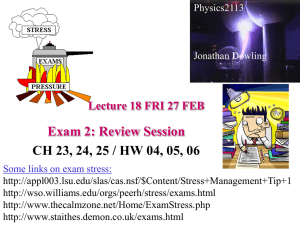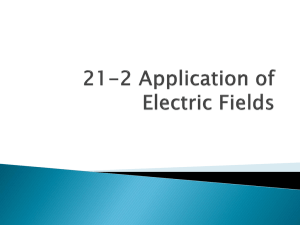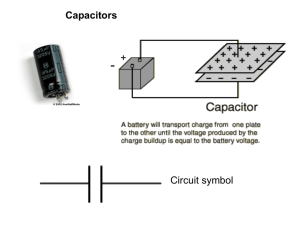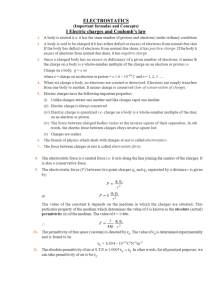Chapter 17: Electric Potential
advertisement
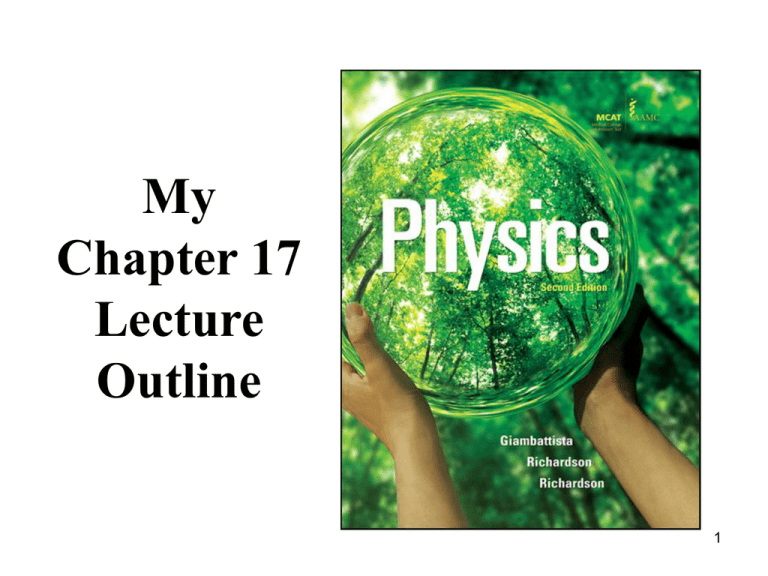
My Chapter 17 Lecture Outline 1 Chapter 17: Electric Potential •Electric Potential Energy •Electric Potential •How are the E-field and Electric Potential related? •Motion of Point Charges in an E-field •Capacitors •Dielectrics 2 §17.1 Electric Potential Energy Electric potential energy (Ue) is energy stored in the electric field. •Ue depends only on the location, not upon the path taken to get there (conservative force). Not a vector. •Ue = 0 at some reference point. •For two point particles take Ue = 0 at r = . kq1q2 •For the electric force U e r 3 Example: A proton and an electron, initially separated by a distance r, are brought closer together. (a) How does the potential energy of this system of charges charge? ke2 For these two charges U e r Bringing the charges closer together decreases r:. Ue Uef Uei 0 This is like a mass falling near the surface of the Earth; positive work is done by the field. 4 Example continued: (b) How will the electric potential energy change if both particles have positive (or negative) charges? When q1 and q2 have the same algebraic sign then Ue > 0. This means that work must be done by an external agent to bring the charges closer together. 5 Example: What is the potential energy of three point charges arranged as a right triangle? (See text Example 17.2) q2 q2 r12 q1 Ue 0 r12 r23 q3 r13 kq1q2 kq1q3 kq2 q3 r12 r13 r23 q1 r23 q3 r13 kq1q2 kq1q3 kq2 q3 Ue 0 r12 r13 r23 Are these the same? 6 §17.2 Electric Potential Electric potential is the electric potential energy per unit charge. Ue V qtest Electric potential (or just potential) is a measurable scalar quantity. Its unit is the volt (1 V = 1 J/C). 7 For a point charge of charge Q: U e kQ V qtest r When a charge q moves through a potential difference of V, its potential energy change is Ue = qV. 8 Example: A charge Q = +1 nC is placed somewhere in space far from other charges. Take ra = 1.0 m and re = 2.0 m. f b c e a Q d g 9 Example continued: Place a charge of +0.50 nC at point e. What will the change in potential (V) be if this charge is moved to point a? kQ 9.0 109 Nm2 /C 2 1.0 nC Ve 4.5 Volts re 2m kQ 9.0 109 Nm2 /C 2 1.0 nC Va 9.0 Volts ra 1m V = Vf Vi = Va Ve = +4.5 Volts 10 Example continued: What is the change in potential energy (U) of the +0.50 nC charge ? Ue = qV = (+0.50 nC)(+4.5 Volts)= +2.3 nJ 11 §17.3 The Relationship between E and V f b The circles are called equipotentials (surfaces of equal potential). c e a Q +9 V +4.5 V d g 12 The electric field will point in the direction of maximum potential decrease and will also be perpendicular to the equipotential surfaces. f b c e a Q +9 V +4.5 V d g 13 Equipotentials and field lines for a dipole. 14 Uniform E-field V1 V2 V3 V4 E Equipotential surfaces U e V Ed q Where d is the distance over which V occurs. 15 §17.4 Moving Charges When only electric forces act on a charge, its total mechanical energy will be conserved. Ei E f 16 Example (text problem 17.40): Point P is at a potential of 500.0 kV and point S is at a potential of 200.0 kV. The space between these points is evacuated. When a charge of +2e moves from P to S, by how much does its kinetic energy change? Ei E f Ki U i K f U f K f K i U i U f U f U i U qV q Vs V p 2e 200.0 500.0 kV 9.6 1014 J 17 Example (text problem 17.41): An electron is accelerated from rest through a potential difference. If the electron reaches a speed of 7.26106 m/s, what is the potential difference? Ei E f 0 Ki U i K f U f K f U qV 1 2 m vf qV 2 2 2 31 6 m vf 9.11 10 kg 7.26 10 m/s V 2q 2 1.60 1019 C 150 Volt s Note: the electron moves from low V to high V. 18 §17.5 Capacitors A capacitor is a device that stores electric potential energy by storing separated positive and negative charges. Work must be done to separate the charges. + + + + + + + Parallel plate capacitor – – – – – – – 19 For a parallel plate capacitor: EQ E V Q V Written as an equality: Q = CV, where the proportionality constant C is called the capacitance. 20 What is the capacitance for a parallel plate capacitor? Q V Ed d d 0 0 A 0 A Q d V C V where C 0 A d . Note: C depends only on constants and geometrical factors. The unit of capacitance is the farad (F). 1 F = 1 C2/J = 1 C/V 21 Example (text problem 17.56): A parallel plate capacitor has a capacitance of 1.20 nF. There is a charge of magnitude 0.800 C on each plate. (a) What is the potential difference between the plates? Q CV Q 0.800 C V 667 Volt s C 1.20 nF 22 Example continued: (b) If the plate separation is doubled, while the charge is kept constant, what will happen to the potential difference? Q Qd V C 0 A V d If d is doubled so is the potential difference. 23 Example (text problem 17.100): A parallel plate capacitor has a charge of 0.020 C on each plate with a potential difference of 240 volts. The parallel plates are separated by 0.40 mm of air. (a) What is the capacitance of this capacitor? Q 0.020 C C 8.3 10 11 F 83 pF V 240 Volts 24 Example continued: (b) What is the area of a single plate? C A 0 A d Cd 0 83 pF0.40 mm 8.851012 C 2 /Nm2 0.0038m 2 38 cm2 25 §17.6 Dielectrics As more and more charge is placed on capacitor plates, there will come a point when the E-field becomes strong enough to begin to break down the material (medium) between the capacitor plates. 26 To increase the capacitance, a dielectric can be placed between the capacitor plates. C C0 where C0 0 A d and is the dielectric constant. 27 Example (text problem 17.71): A capacitor can be made from two sheets of aluminum foil separated by a sheet of waxed paper. If the sheets of aluminum are 0.3 m by 0.4 m and the waxed paper, of slightly larger dimensions, is of thickness 0.030 mm and has = 2.5, what is the capacitance of this capacitor? C0 0 A d 8.851012 Nm2 /C 2 0.40* 0.30m 2 0.030103 m 3.54108 F and C C0 2.5 3.54108 F 8.85108 F. 28 §17.7 Energy Stored in a Capacitor A capacitor will store energy equivalent to the amount of work that it takes to separate the charges. 29 The energy stored in the electric field between the plates is: 1 U QV 2 1 2 C V 2 Q2 2C } These are found by using Q = CV and the first relationship. 30 Example (text problem 17.79): A parallel plate capacitor is composed of two square plates, 10.0 cm on a side, separated by an air gap of 0.75 mm. (a) What is the charge on this capacitor when the potential difference is 150 volts? Q CV 0 A d V 1.77 10 8 C (b) What energy is stored in this capacitor? 1 U QV 1.33 10 6 J 2 31 Summary •Electric Potential Energy •Electric Potential •The Relationship Between E and V •Motion of Point Charges (conservation of energy) •Parallel Plate Capacitors (capacitance, dielectrics, energy storage) 32
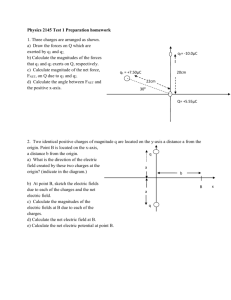

![Sample_hold[1]](http://s2.studylib.net/store/data/005360237_1-66a09447be9ffd6ace4f3f67c2fef5c7-300x300.png)

